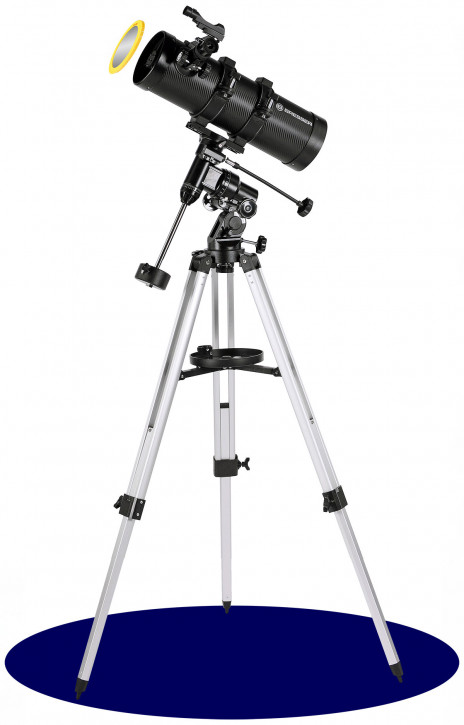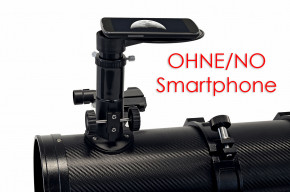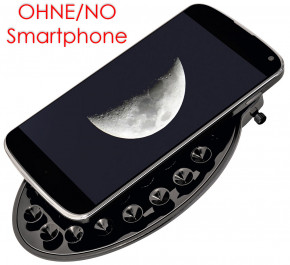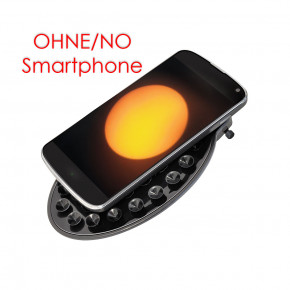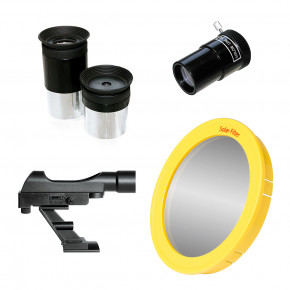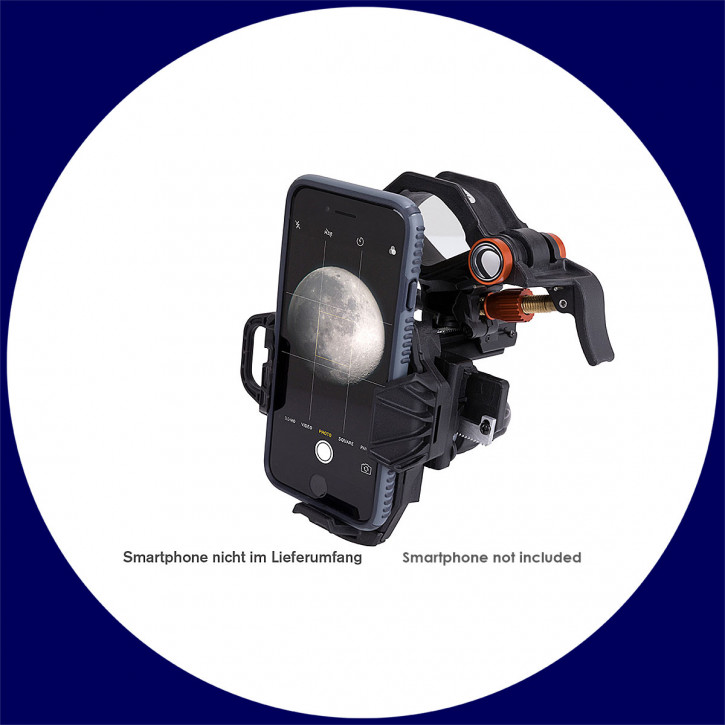BRESSER Pluto 114/500mm EQ3 Reflector Telescope with Smartphone Adapter & Solar Filter
Product.Nr.:
BR#4614500
EAN: 4007922145136
products condition: new
Manufacturer: Bresser
299,00 EUR
incl. 19 % VAT
- 114/500mm reflector telescope
- Solid equatorial EQ3 mount
- Lightweight, height-adjustable tripod
- LED red dot finder
- Mobile phone holder for photographic snapshots
- Certified solar filter for safe solar observation (NEVER LOOK INTO THE SUN WITHOUT A FILTER - RISK OF BLINDNESS!)
- Simple eyepieces for the first observations
- Detailed operating instructions
Are you looking for a telescope for your child and can't find what you're looking for in the "cheap price segment"? Then you now know where you can get advice before you make a bad purchase and your child may not even look through a telescope afterwards because everything wobbles like a dachshund or vibrates like a tuning fork and you are beginning to realise why this telescope may cost a little more than you originally wanted to spend.
Let's take a look at the telescope together, because unfortunately this telescope is not quite perfect either (expensive ones sometimes aren't either), but you can do a lot more with this telescope than with others, as it is a little more stable overall.
Let's start from the bottom up, the way a telescope is set up.
Aluminium tripod
A very light, height-adjustable aluminium tripod. Lightweight sounds good, but it could be a little more stable/heavier and thus more torsion-resistant - here it is sufficient, the tripod legs should only be extended to approx. 2/3 if possible, as this generally contributes to stability.
The tripod tray holds the accessories.
Equatorial (parallactic) mount
The EQ3 mount offers a very solid basis here, because most mounts - in this entry-level class - are simple and unfortunately always too small, practically the centrepiece of an entire telescope.
The mount is tracked by hand to compensate for the rotation of the earth. Because it is an equatorial mount, which is aligned parallel to the earth's axis, it only needs to be adjusted in one axis and not in both axes, as is the case with many entry-level telescopes.
Later, the mount can be upgraded with optional motors - this improves observation comfort (less wobble = more details of objects).
Optics
A Newtonian reflector telescope with 114mm aperture and 500mm focal length (focal ratio ("aperture") = f/4.4).
The larger the aperture, the more light a telescope can absorb and thus finer details become visible and objects are imaged somewhat brighter.
The focal length is important for the magnification - here it offers a good average.
Whether planets, the moon, star and globular clusters, nebulae and galaxies, almost everything can be observed with it. Celestial objects vary in size due to the distance, and this is also the case in the telescope.
You can also use the telescope to look at nature during the day. You may remember from physics lessons that the image is upside down and inverted - but under the starry sky it's not really a problem, you get used to it very quickly.
The focuser is made entirely of plastic and accepts standardised accessories with 31.75mm (1.25-inch).
The tube is covered with carbon fibre optics.
Accessories
- Viewfinder: The objects are focussed using an LED red dot finder with zero magnification.
- Eyepieces: 20mm + 4mm
The eyepieces are responsible for the image and magnification (formula: magnification = telescope focal length : eyepiece focal length).
This brings us to the crux of the matter, because these should actually be replaced directly with higher-quality ones. They are still just about suitable for the first steps, but the 4mm eyepiece is simply too much of a good thing, because the "marketing experts" wanted to go for a high magnification rather than a sensible magnification at which something can be seen.
In other words, the 20mm eyepiece can be used for observation, the 4m eyepiece rather not - perhaps on the moon, but it is actually too much.
Something around 12-8mm focal length and a 6-5mm eyepiece as the "lower limit" for the highest magnification would make sense.
- The Barlow lens with a factor of three has been selected far beyond the target and can only just be used with a 20mm eyepiece.
It divides the eyepiece focal length by the specified factor and here at the latest you will realise that the 4mm eyepiece and Barlow lens are unsatisfactory for the "marketing experts".
Formula: Eyepiece focal length : Barlow factor = new eyepiece focal length
or: Magnification x Barlow factor = new magnification
- Smartphone camera adapter suitable for the first snapshots, i.e. all bright objects such as the moon, planets or even the sun (ONLY WITH FILTER!!!).
ATTENTION: The mobile phone must sit firmly on the holder and must not slip down, if necessary there are better smartphone adapters, e.g. the Celestron NexYZ (BP#825821).
- Solar filter
SAFETY NOTE: Please NEVER observe the sun WITHOUT a suitable (=certified) FILTER - otherwise there is an immediate risk of blindness.
You have exactly two attempts: left eye, right eye.
With this filter you can observe the sun completely safely, it is always placed in front of the telescope opening (i.e. where the dust cover is normally located).
Important: You must NOT look for the sun in the viewfinder, otherwise you will also suffer eye damage - you can align the telescope to the sun using the so-called shadow method - we will be happy to explain this to you.
- Operating instructions
A very detailed instruction manual is included.
Our conclusion
You may have to dig a little deeper into your wallet, but in return you get a pretty good basic set-up to get you started in the fascinating hobby of astronomy.
Once the urge to explore has been awakened, the eyepieces and the Barlow lens should be exchanged for higher quality ones.
Astrophotography?
The telescope is only suitable for astrophotography to a limited extent, snapshots are not the problem, rather the long exposure, which is responsible for the "bright colours". You can extend the telescope further, but we recommend that you switch to a completely different, better system if astrophotography is your main focus (e.g. from the age of 15/16 years upwards) - this one is not really designed for that.
Astronomy can be an expensive hobby, so get other family members and friends involved.
If you've made it this far, you'll realise that there really is no such thing as a one-size-fits-all telescope.
You are welcome to pick up the telescope by appointment and if you bring some time with you, we can do a trial assembly together - free of charge, of course (even if the margin doesn't really allow it).
Technical Data
| Field of application | |
|---|---|
| Focus group | |
| Product family | |
| OPTICAL SPECIFICATIONS | |
| ELECTRONICS, HARDWARE & SOFTWARE | |
| GENERAL TECHNICAL DATA | |
| DIMENSIONS & WEIGHTS | |
| Field of application |
|
| Focus Group | Beginners |
| Product Family | Reflector telescope |
| Optical design | Newtonian Reflector |
| Magnification from | 25 |
| Magnification up to | 375 |
| Maximum recommended magnification | 230 |
| Secondary mirror diameter | 40 mm |
| Mirror/Lens diameter | 114 mm |
| Focal length | 500 mm |
| Aperture ratio | 4.4 |
| Finderscope | LED-Red Dot Finder |
| Batteries needed2 | CR 2032 |
| Batteries included | ✓ |
| Software | Stellarium Astronomy software |
| Colour | Carbon Fiber |
| Fine movements | Manual (RA and DEC) |
| Material tripod3 | Aluminium |
| Dust protection caps | Dust protection caps for open aperture and eyepiece holder |
| Mount Type | German/Equatorial Mount |
| Extended Bresser-warranty | 5 years |
| Tube length | 500 mm |
| Tripod height adjustment | ✓ |
Scope of Delivery
- BRESSER Pluto 114/500 EQ3 reflector telescope
- Aluminium tripod
- Accessory tray
- Equatorial EQ3 mount with flexible shafts in both axes
- Eyepieces: 20mm and 4mm (1.25" receptacles)
- Barlow lens 3x (1.25-inch receptacle)
- LED red dot finder incl. battery
- Solar filter
- Smartphone camera adapter
- Astronomy software for download
- Operating instructions
Manufacturer identification
Manufacturer identification
Name: Bresser GmbHE-Mail adress: info@bresser.de
Streetaddress: Gutenbergstraße 2
ZIP Code: 46414
City: Rhede
Country: DE
Phone: +49 2872 8074 0

